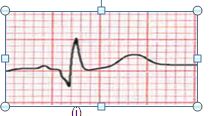Body Fluids and Circulation - Online Test
Q1.
Which of the following statements doesn’t hold true for blood clotting cascade?
i. Ruptured platelets release thromboplastin.
ii. Prothrombinis converted into thrombin in the presence of vitamin K and Na+ions.
iii. Fibrinogen is converted into fibrin through enzymatic action of thrombin in the presence of Ca++ions
iv. Fibrin makes clot via process of polymerisation.
Answer : Option B
Explaination / Solution:
Ruptured platelets release thromboplastin. Fibrinogen present in blood plasma is converted into fibrin through enzymatic action of thrombin. Fibrin makes clot via process of polymerisation.
Q2. Read the following :
i. The instrument used for recording heart’s electrical events is named electrocardiogram.
ii. In any ECG the part of base line between any two deflections is called interval.
iii. Abnormality in the working of heart changes wave pattern of ECG.
i. The instrument used for recording heart’s electrical events is named electrocardiogram.
ii. In any ECG the part of base line between any two deflections is called interval.
iii. Abnormality in the working of heart changes wave pattern of ECG.
Answer : Option B
Explaination / Solution:
ECG is a graphical representation of the electrical activity of the heart during a cardiac cycle.
Q3. The mass of tissue seen in the left corner of the right atrium close to the atri-ventricular septum is
Answer : Option D
Explaination / Solution:
Atrioventricular Node or AV node is compact half oval mass of myogenic fibres which lies in the posterior septal wall of right atrium near the opening of coronary sinus. It receives impulse from SA node and transmits it to ventricles.
Q4.
Look at the following ECGs:

Answer : Option B
Explaination / Solution:
Both electro cardiogram (ECG) represents myocardial infarction in which heart do not receive the sufficient oxygen due to blockage of coronary artery.
Q5. Blood pressure is expressed as the ratio of systolic over diastolic pressure. The difference between systolic and diastolic pressure is called pulse pressure. What will be its value for a normal healthy adult?
Answer : Option A
Explaination / Solution:
Pulse pressure is the difference between the systolic and diastolic pressure readings. It is measured in millimeters of mercury (mmHg). It represents the force that the heart generates each time it contracts. If resting blood pressure is (systolic-diastolic) 120-80 millimeters of mercury (mmHg), pulse pressure is 40
Q6. Each cardiac cycle takes 0.8 seconds to occur. Calculate how many cardiac cycles occur in 4 minutes ?
Answer : Option C
Explaination / Solution:
4 min = 240 sec. Therefore, 240/0.8 = 300 cardiac cycles.
Q7. In the human heart :
i. The valve between right atrium and right ventricle is tricuspid while valve between left atrium and left ventricle is mitral valve.
ii. Openings of the right and the left ventricles into the pulmonary artery and the aorta are guarded by semilunar valves.
iii. ‘Lub’ the first sound which is low pitched is caused by the closure of semilunar valves while ‘Dub’ the second sound which is high pitched is caused by the closure of bicuspid and tricuspid valves.
i. The valve between right atrium and right ventricle is tricuspid while valve between left atrium and left ventricle is mitral valve.
ii. Openings of the right and the left ventricles into the pulmonary artery and the aorta are guarded by semilunar valves.
iii. ‘Lub’ the first sound which is low pitched is caused by the closure of semilunar valves while ‘Dub’ the second sound which is high pitched is caused by the closure of bicuspid and tricuspid valves.
Answer : Option A
Explaination / Solution:
The first heart sound (lub) is associated with the closure of the tricuspid and bicuspid valves whereas the second heart sound (dub) is associated with the closure of the semilunar valves.
Q8. The left atrium receives deoxygenated blood in :
Answer : Option A
Explaination / Solution:
Deoxygenated blood from body parts reaches to left atrium of lizards but in human beings left atrium receives the oxygenated blood.
Q9.
Read the following statements :
i. when the heart is not pumping blood sufficient to meet the need of the body then this state is called as heart attack.
ii. when the heart stops beating due to irreversible death of cells then this state is called as heart failure.
Answer : Option C
Explaination / Solution:
The state when the heart is not pumping blood sufficient to meet the need of the body then this state is called heart failure. When the heart muscles is suddenly damaged due to inadequate blood supply is called heart attack.
Q10. In the systemic circulation, blood vessel that carries blood from the intestine to liver is named :
Answer : Option C
Explaination / Solution:
The hepatic portal vein carries blood from intestine to the liver before it is delivered to the systemic circulation.
